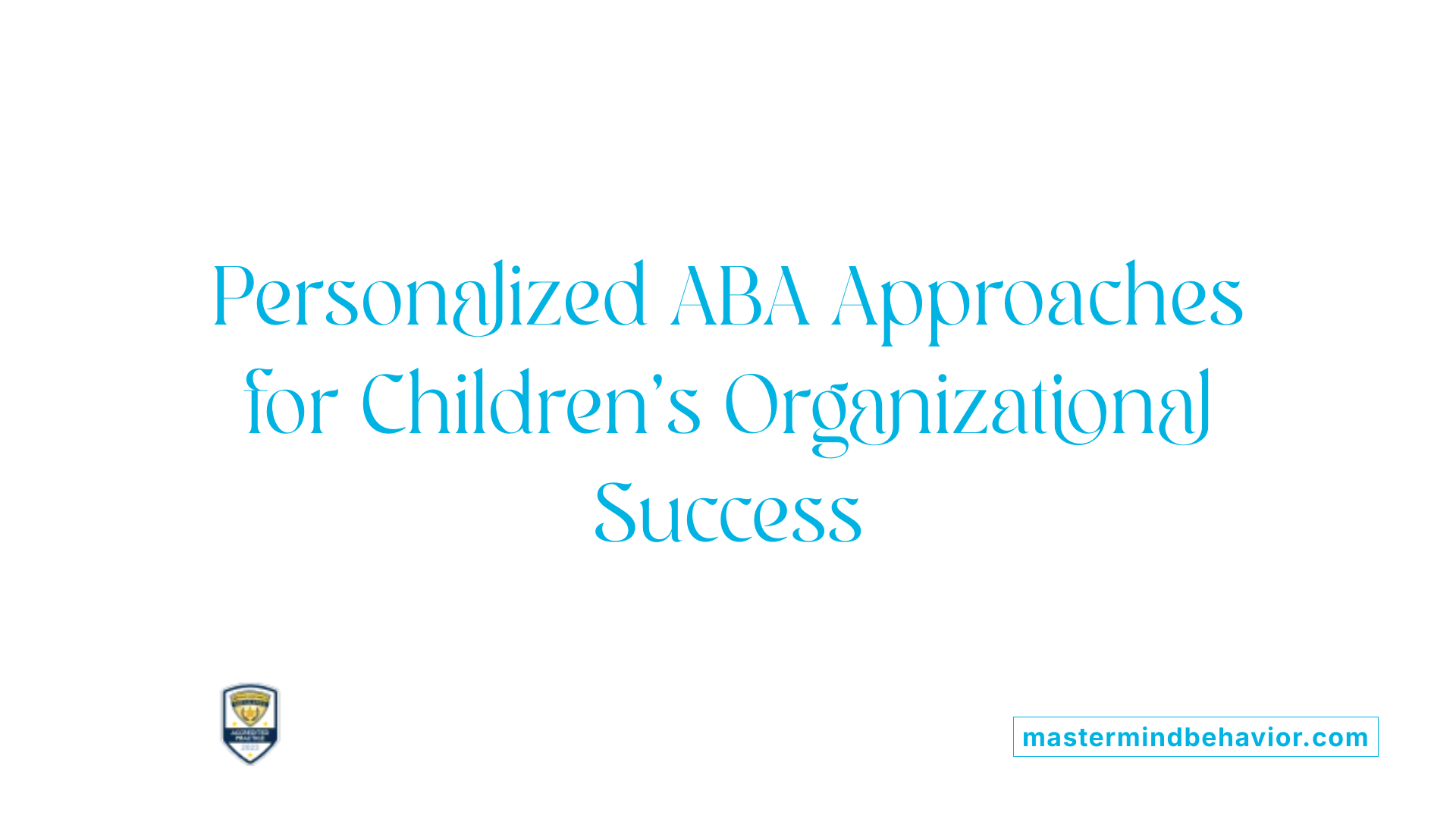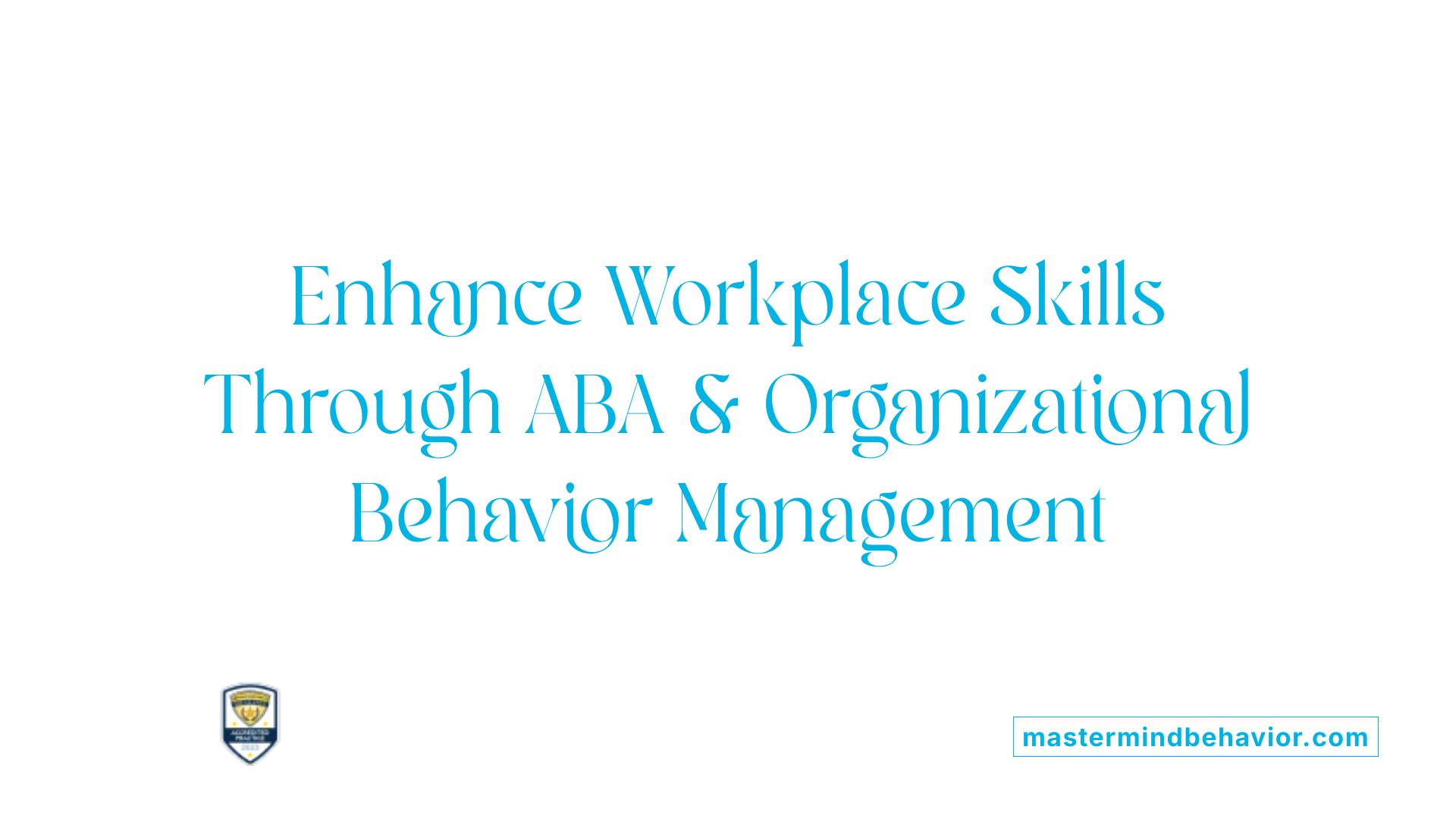Unlocking Organizational Potential with ABA Therapy
Behavioral interventions grounded in Applied Behavior Analysis (ABA) have become pivotal in fostering essential organizational skills in individuals with autism and other developmental disabilities. By employing evidence-based techniques tailored to individual needs, ABA therapy equips individuals across the lifespan with tools for planning, focusing, and executing tasks effectively. This article explores how ABA therapy supports the development of organizational skills, the strategies used, and the impact on daily functioning and workplace efficiency.
Foundational Principles of ABA in Skill Development
 Applied Behavior Analysis (ABA) is rooted in understanding the behavior of individuals and applying systematic strategies to promote meaningful change. One of its core principles involves reinforcement—using rewards to increase desirable behaviors—and repetition, which helps solidify new skills through consistent practice.
Applied Behavior Analysis (ABA) is rooted in understanding the behavior of individuals and applying systematic strategies to promote meaningful change. One of its core principles involves reinforcement—using rewards to increase desirable behaviors—and repetition, which helps solidify new skills through consistent practice.
A fundamental aspect of ABA is customizing interventions to meet each person’s unique needs. This individualized approach ensures that techniques are effective and relevant. For example, ABA practitioners create structured plans that align with the interests and abilities of the individual, fostering engagement and progress.
In developing skills like organization, ABA employs several key strategies. Visual supports, such as schedules and social stories, help clarify expectations and routines. Task analysis breaks down complex activities into manageable steps, making them less overwhelming. Reinforcing successful completion of each step encourages persistence and mastery.
Overall, ABA integrates these principles to support individuals in gaining independence and improving their daily functioning. By focusing on positive reinforcement, customized plans, and repetitive practice, ABA creates an enriching environment for learning vital skills that enhance quality of life.
Techniques and Strategies for Building Organization Skills

What techniques and strategies are used in ABA therapy to improve organizational skills?
ABA therapy uses a variety of targeted approaches to help individuals develop stronger organizational abilities. One fundamental method is task analysis, where complex tasks are divided into small, manageable steps. This breakdown allows individuals to learn and complete each part systematically, reducing overwhelm and increasing confidence.
In addition, behavior chaining is employed to teach sequential activities. For example, helping a child learn to brush their teeth involves mastering each step in order, from picking up the toothbrush to rinsing.
Visual supports play a crucial role—using charts, pictures, and videos—to help individuals understand what needs to be done. These visual prompts clarify expectations and foster independence in task management.
Prompting and fading are techniques that support learning gradual independence. Initially, prompts guide actions, but over time, those prompts are slowly removed, encouraging the individual to perform tasks on their own.
Reinforcement strategies are also vital. Using positive reinforcement, therapists and caregivers reward organized behaviors, motivating ongoing effort. For example, earning a favorite activity after completing a list of chores can reinforce the habit.
Furthermore, behavior contracts specify behavioral expectations and rewards, providing clear structure and accountability. Finally, script fading, which involves gradually reducing prompts for social or organizational skills, helps generalize learned behaviors across different environments.
These combined strategies create a comprehensive approach that promotes not only task completion but also sustainable organizational skills.
| Technique/Strategy | Purpose | Additional Details |
|---|---|---|
| Task Analysis | Break down complex tasks | Simplifies learning; step-by-step mastery |
| Behavior Chaining | Teach sequences of activities | Builds complex skills through linked steps |
| Visual Supports | Enhance understanding | Charts, pictures, videos to cue behaviors |
| Prompting & Fading | Support learning gradually | Prompts are reduced over time for independence |
| Reinforcement | Encourage desired behaviors | Rewards motivate ongoing effort |
| Behavior Contracts | Set clear behavioral expectations | Formal agreements with rewards or consequences |
| Script Fading | Improve social and organizational skills | Gradually remove guides for independent performance |
Understanding and applying these strategies effectively can significantly enhance organizational success for individuals with autism and developmental challenges, empowering them to manage daily activities with confidence.
Applying ABA Principles to Different Age Groups

How can ABA principles be applied to improve organizational skills in children?
ABA (Applied Behavior Analysis) principles are highly effective in teaching and enhancing organizational skills in children. This is achieved through systematic strategies like reinforcement, data tracking, and tailored interventions that help children develop habits like planning, initiating tasks, and completing activities.
Visual aids such as charts and schedules, along with prompting methods, support children in understanding expectations and generalizing learned skills across different environments like home and school. Behavior analysts analyze antecedents (what happens before a behavior), behaviors themselves, and consequences (what happens after) to customize approaches that address specific organizational challenges.
Overall, ABA emphasizes personalized, evidence-based techniques that foster independence and improve daily functioning by helping children manage their belongings, time, and responsibilities more effectively.
Behavior Management and Skill Acquisition in Organizational Contexts

How does ABA for behavior management relate to skill acquisition in organization?
ABA (Applied Behavior Analysis) for behavior management is fundamentally connected to developing skills in organizational settings. Key techniques include reinforcement, shaping, and behavior modification, which help reinforce desired workplace behaviors while reducing maladaptive ones.
In the context of organizations, Organizational Behavior Management (OBM) applies ABA principles specifically to improve work performance, motivation, and overall culture. OBM uses tools like performance diagnostics, consistent feedback, and targeted training programs to enhance employees’ skills and behaviors.
These ABA-driven strategies support personal and team development by fostering effective communication, leadership, and efficient task execution. For instance, employing positive reinforcement boosts productivity and helps develop problem-solving skills. Over time, these interventions lead to sustainable improvements in organizational functioning.
Overall, ABA techniques serve as the backbone of OBM, enabling a systematic approach to building skills and modifying behaviors efficiently across workplaces.
What is Organizational Behavior Management (OBM) and how does it relate to ABA methods for improving workplace organization and efficiency?
Organizational Behavior Management (OBM) is a specialized application of ABA that focuses on optimizing work environments to improve behavioral performance. It aims to enhance employee engagement, safety, and output through evidence-based strategies.
OBM employs ABA concepts such as reinforcement, task clarification, goal setting, and timely feedback. These methods help identify environmental factors influencing employee behaviors and design interventions for improvement.
Assessment tools like the Performance Diagnostic Checklist help pinpoint issues within work systems and facilitate targeted solutions. By improving workplace culture and reducing issues like burnout and high turnover, OBM creates a more productive and satisfying environment.
In essence, OBM translates behavioral science into practical strategies to elevate organizational efficiency. It addresses problems systematically, fostering behavioral change that benefits both employees and the organization as a whole.
| Topic | Description | Related Techniques |
|---|---|---|
| Behavior Management | Strategies to promote desired workplace behaviors | Reinforcement, behavior shaping, extinction |
| Skill Development | Building specific competencies in employees | Training, modeling, prompts |
| Workplace Efficiency | Improving overall organizational function | Feedback, performance diagnostics, goal setting |
Understanding the link between ABA strategies and OBM highlights how behavioral science can drive meaningful improvements in work environments, ultimately supporting personal growth and organizational success.
Fostering Independence and Success
Overall, ABA therapy offers comprehensive, adaptable strategies for enhancing organizational skills across various age groups and settings. By leveraging techniques such as visual supports, task analysis, reinforcement, and behavior management, ABA helps individuals develop the skills necessary for managing routines, completing tasks, and navigating social and professional environments effectively. Its personalized approach ensures that interventions are tailored to individual needs and developmental levels, fostering independence and promoting successful life outcomes. Whether in educational settings, workplaces, or daily home routines, ABA’s evidence-based methodologies continue to prove instrumental in empowering individuals to achieve their full potential, leading to a more organized, confident, and autonomous life.
References
- Exploring the Connection Between Autism and Organization Skills
- A Guide to Creating Engaging ABA Activities for Children
- ABA Therapy for Leadership Skills: Empowering Children
- How ABA Therapy Can Help Adults Live Better Lives
- 5 Ways ABA Therapy Helps with Classroom Adaptations
- Who Benefits Most from ABA Therapy? A Detailed Guide
- Using Organizational Behavior Management in ABA organizations









